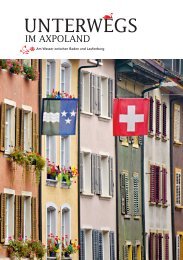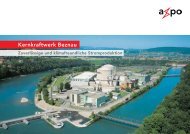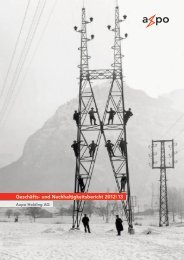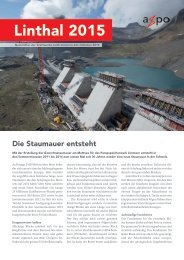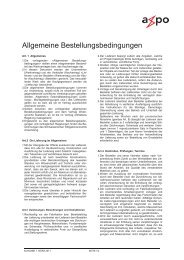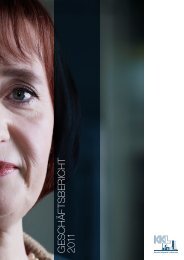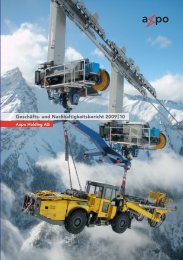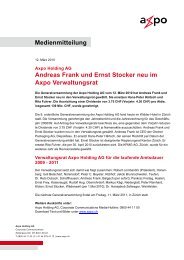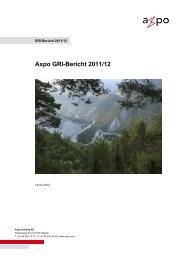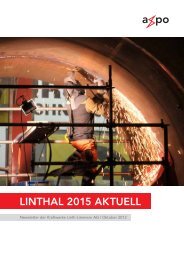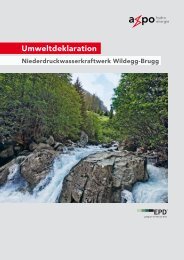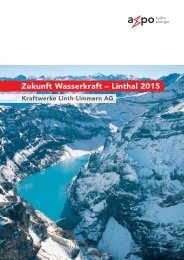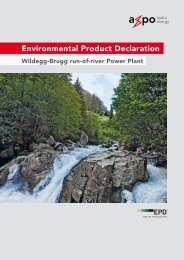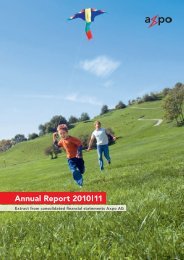Annual report 2008/09 - Axpo Group
Annual report 2008/09 - Axpo Group
Annual report 2008/09 - Axpo Group
Create successful ePaper yourself
Turn your PDF publications into a flip-book with our unique Google optimized e-Paper software.
Electricity from nuclear energy is a supporting pillar of the<br />
Swiss electricity supply system. As this not only keeps<br />
electricity prices low but also ensures low CO2 emissions, it<br />
is clear to <strong>Axpo</strong> that these benefi ts must be secured for<br />
the future – in Switzerland and worldwide.<br />
Hybrid cooling towers for Beznau and<br />
Mühleberg<br />
The replacement nuclear power plants at<br />
Beznau and Mühleberg will have increased<br />
output. Moreover, they will no longer need<br />
river water for cooling. Instead, cooling will<br />
take place by means of hybrid cooling towers<br />
which, at a height of approximately 60<br />
metres, are substantially lower than “traditional”<br />
cooling towers such as the 150 metrehigh<br />
tower at Gösgen. They therefore do<br />
not spoil the landscape to the same extent.<br />
The second major benefi t lies in the fact<br />
that they release hardly any visible steam<br />
because the steam is mixed with dry,<br />
warm air.<br />
From nuclear power plant to recycling<br />
When they are removed from the reactor after<br />
three to four years’ service life, spent<br />
fuel rods contain only 4 % radioactive waste,<br />
while the remaining 96 % of the fuel can<br />
still be used as nuclear fuel. The re-usable<br />
nuclear fuel is separated from the highlevel<br />
radioactive waste at reprocessing<br />
plants, such as the plant at La Hague in<br />
France, and is available again for electricity<br />
generation.<br />
The fi ve Swiss nuclear power plants have an annual output of<br />
around 25 billion kilowatt-hours of electricity, thereby cover -<br />
ing 40% of Swiss electricity production. Nuclear energy is not<br />
only extremely competitive – current production costs amount<br />
to approximately 6 cents per kilowatt-hour of electricity – but<br />
it is also very climate-friendly. If we consider the CO2 output<br />
for the whole cycle from the mining of the uranium to the disposal<br />
of the radioactive waste, nuclear energy comes second<br />
only to hydropower. If the electricity produced in Switzerland<br />
by nuclear energy were to be generated in modern gas-fi red<br />
combined cycle power plants, the same volume of CO2 would<br />
be released into the air as is currently emitted by all the car<br />
traffi c in Switzerland.<br />
Replacement nuclear power plants urgently needed<br />
Switzerland is likely to see a power supply shortage from 2020<br />
onwards, when the oldest nuclear power plants at Beznau and<br />
Mühleberg will reach the end of their operating lives and important<br />
electricity import contracts with France will start running<br />
out. The foreseeable supply shortage can only be countered<br />
by replacing the existing nuclear power plants.<br />
As <strong>Axpo</strong> would like to secure this cost-effective and<br />
low-CO2 supply of electricity for its customers in Switzerland,<br />
it submitted the relevant applications for general licences at<br />
the end of <strong>2008</strong>. Advanced third-generation reactors with even<br />
better safety features, greater effi ciency and operating profi tability<br />
will be used in the replacement nuclear power plants<br />
to be built on the present sites.<br />
Uranium reserves will last for a long time<br />
According to the Organization for Economic Cooperation and Development<br />
(OECD), the known uranium reserves that are commercially<br />
recoverable will last for another 100 years at current consumption<br />
rates. The map shows the distribution of these reserves.<br />
The speculative reserves for conventionally-mined uranium will<br />
last for more than 300 years.<br />
Source: OECD/IAEO, “Red Book”, 2007<br />
329<br />
339<br />
Canada<br />
USA<br />
157<br />
Niger 243<br />
Brazil<br />
Namibia 176<br />
Ukraine<br />
135<br />
284<br />
Kasakhstan<br />
72<br />
378<br />
172<br />
Uzbekistan<br />
46 Mongolia<br />
44 Jordan<br />
49 China<br />
49 India<br />
South Africa<br />
Australia<br />
725<br />
Russia



